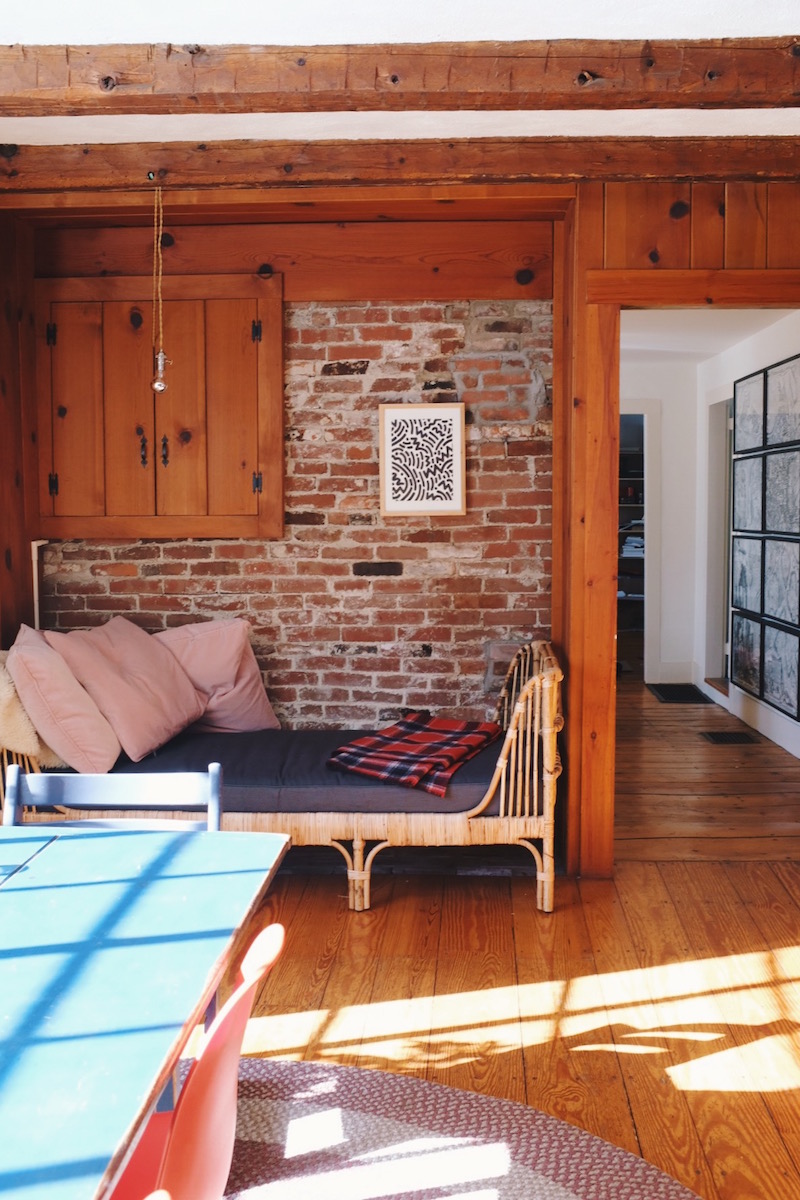-
Read Aloud
Because of the crazy times, lots of people are suddenly home with their young children for extended and unexpected periods of time. I’m writing up a few general ideas I’ve learned over the years of being at home with one, two, three, and now four children.
General idea number two…

Read Aloud.
You don’t have textbooks, curriculum, flashcards, or workbooks. But you have a something wildly more powerful than any of that. Something that will increase their vocabulary, strengthen their listening comprehension, give you a shared language of characters, and all but guarantee that they will love books as adult. And if they love books, then they love learning, and (dusts hands) that’s the best it can get.
To begin, plan to read aloud for one hour. But aspire to two hours. You will get there sooner than you think. Pick a few books to move between within that hour. Books with long words and dense story lines that one can listen to while sprawled on the floor, staring at the cracks in the ceiling.
Books like Anne of Green Gables, Birchbark House, The Hobbit, Chronicles of Narnia, The Laura Ingalls Series, The Penderwicks, Twenty-One Balloons, Mrs. Piggle-Wiggle series, Dr. Dolittle, and My Father’s Dragon.*
After you read one chapter, ask “Should I read another chapter?” And they will likely surprise both of you by shouting,”Yes!”
But if they say no, move on to the next book and read a chapter of that. If you have a book of poetry, or Winnie-the-Pooh which is basically poetry,` read a few pages of that. If you have something really dense, like actual history like The Story of the World or Our Island Story, read one chapter and don’t expect more.
I like to read in the morning, right after breakfast. Morning energy is often a little wild, creative but not directed quite yet, and very cuddly. For whatever reason, in the morning, it’s easiest for all ages to find a comfortable place to sit and to listen for a few hours. After an hour or two, I get up and say something like, “Ho! I have to start lunch,” and walk off and the rest of the day begins.
If you have a child younger than age four in your group, there are a few things you can do to include them. 1: Read several illustrated books of their choice to begin with. Read to them first. 2: Provide something for them to do nearby while you read aloud, like markers and paper, a puzzle, magnatiles. They’ll do it for a little while and likely wander off. You will have to remind them not to interrupt you. They will forget, of course, but they will begin to get it, over time.
* We’ve read all of the books listed above to children ages five and older, and they loved them. But lighter options that are great for reading aloud (I think of these as afternoon books) include the original Boxcar Children (any book between #1-20) and the older American Girl series books: Samantha, Kirsten, Addy, Molly, Felicity. There are loads of book lists online, this is an educational approach you can really lean into. If you need more ideas, let me know.
-
You are Not the Entertainment.
Because of the crazy times, lots of people are suddenly home with their young children for extended and unexpected periods of time. I’m writing up a few general ideas I’ve learned over the years of being at home with one, two, three, and now four children.
General idea number one…

You are Not the Entertainment.
You are a provider who sources food, keeps a roof intact, equips a bed, encourages brushing teeth, and coos softly over headaches and stubbed toes. You are not an entertainer.
With the exception of one highly concentrated 45 minutes a day, you are not available to play.*
You are a pond, and your child is a frog. You are lily pads that they like to hop on every once in a while. You do not have good ideas for interesting games. You do not know what might be fun. You have a speckle of imagination, a leftover algae of green krongu imagination, to their utter essence of it. One of your imagination speckles is actually something they told you they were interested in, and you can periodically repeat this back to them.
Your child is returning to you from a scheduled environment where they have been interrupted ceaselessly: just settled on a good game? Playtime is over. lunchtime? Is now over. You were still writing? Stop writing. They adapted to interruptions. Now they will have to adapt to no interruptions. It may take three days. It may take four. They will adapt, I promise.
Don’t think for a moment that you have better ideas of what to play than they do, because you don’t. And if you think you do, you will confuse them and they will believe you, for a little while.
You are boggy and slow moving and they can splash through you and swim around to be reminded of what it feels like to be underwater and slow moving. Not only is this a useful approach to keep in mind, it is absolutely the truth.
*Play whatever you and they want during this 45 minutes and live it up. Tag. Hide and seek in a room that has one piece of furniture. Pillow fight. Card game they adore. Extraordinary slow-moving board game that has no winner.
-
to market to market

On a sultry afternoon we arrived with homemade peppermint patties and chilled oreos sprinkled with rose petals and pistachios, an irritable three-year-old, a serene newborn, five hand-sewn felt purses, six hand-drawn cards, and two kids full of optimism. The cookies had to be kept cold. The baby had to stay in the shade. The three-year-old had to be kept away from the money box. It was a moment of balance.

I want, very much, to support my children’s entrepreneurial interests. I want to meet their requests to sell crafts / setup stands / make money all their own with a frank, open gaze that says “I hear you. What an interesting idea you’ve got there.” Kids can learn marketing, money management, product development, and the rich toolbox of manners like eye contact, smiles, and hellos all from a little small business exposure.
I also want to convey ideas like cost of materials, time spent, energy allotment, mom’s general sanity. If I say yes to this idea for our family, I’ll inevitably be saying no to other things along the way. Since we’re new in this town, Joe and I have taken the startup idea of “fail fast” to heart. Try new things quickly and find your favorites like an old local. So last fall when the seven-year-old told me she wanted to have a stand at the market selling art, I said hmmm maybe. This spring I looked up the market manager’s email and emailed her to ask about kid stands. Was that even allowed?
The market manager emailed me back to say they had one day per month when kids were welcome to setup stands and sell whatever they liked. Perfect! I could channel the energy but not sign our whole summer away.
After visiting the market a few times the girls settled on something they thought was deeply underrepresented: cookies. Plus they wanted to sell hand-drawn nature cards, and copies of a simple felt purse they had themselves and loved. We ordered supplies and wrote down costs. I emailed a friend to borrow a table and tent. Joe helped the girls repurpose a box into a sign. We dusted off the picnic blanket and chose some props. One child and I slathered our way through an “easy” peppermint patty recipe from Genius Desserts and portioned them into paper bags. The other child generously peppered rose petals, pistachios, crushed candy canes, and gold sprinkles on Newman’s Os.
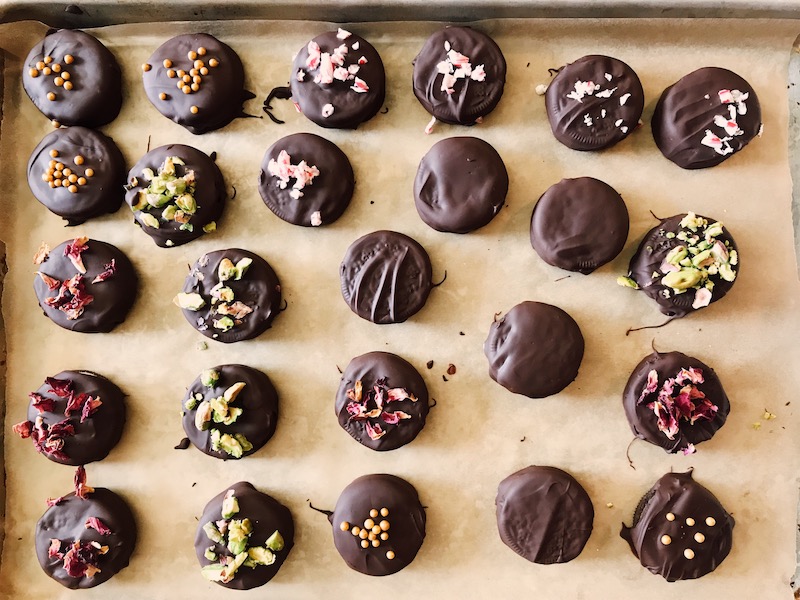
Had we had managed to make ten purses, we would have sold ten. But this was their market, not mine, and so we had five, and sold out in the first hour. One girl’s cookies sold faster than her crafts, the other had the opposite dilemma. Across from us a lemonade stand hammered together with a chalkboard listed a special deal if you bought both a cookie and a lemonade. Small tables lined the corners of the sidewalk, kids sitting on blankets demurely hawking rhubarb pie slices and ball jars hand-plastered with marbles.
 ^^ That’s the only photo I got with the purses, they sold so quickly / I was very busy sitting in the shade acting nondescript. Next time!
^^ That’s the only photo I got with the purses, they sold so quickly / I was very busy sitting in the shade acting nondescript. Next time!



Here’s the funny thing about these things: as an adult I focus on product (cost) and result (money). A good idea? You’ll make millions. Spend a bunch of time and barely covered your costs? Must be a bad idea!
But the girls focused on the people they talked to, the way the market felt, how were they were perceived by the adult customers, how proud they were that they never had to ask for help making change, and didn’t defer to us to answer their questions.
The money they made (after paying us back for costs) was quickly spent at neighboring stands. A woman down the way sells polished stones looped onto soft cords. The girls had been eyeing those for weeks.
So it was totally worth it. But I’m glad it’s only once a month.
-
my mother’s art studio
Hannah, a writer and good friend of mine, once mentioned to me the memories of her mother’s independent afternoons spent painting. Knowing her family was large and homeschooled, I was intrigued to imagine such a vision. I also sensed Hannah’s fondness of these memories and felt I had to know more! For those that homeschool now, hearing memories from a child’s perspective can be a soothing balm to the constant evaluation and re-evaluation that goes on in one’s mind.
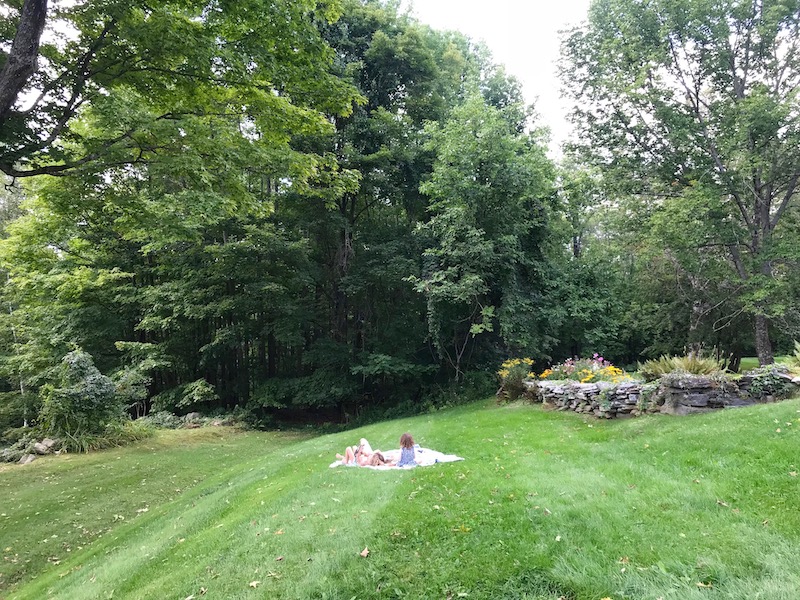 by Hannah Piecush
by Hannah PiecushWhen I was seven my family moved from a New England town with sidewalks and shops to one in the woods. We rented an old white parsonage–although my father was an engineer and not a minister–with a grassy backyard edged by a tumbled stone wall, sugar maples, and a dark row of hemlock trees. The house had enough bedrooms–at last–for all five of us children and a small room at the top of the stairs, with a window looking over the back lawn, that was my mother’s art studio.
The studio was big enough for a wide desk and had shelves where my mother kept her calligraphy pens, boxes of pen nibs, jars of ink, tubes of watercolor pigment, paper of all different textures.
Sometime after our move, my mother arranged for mother’s helpers to come watch the older children in the afternoons while the baby slept and she disappeared into her studio.
These girls were probably only ten or eleven, but they seemed so much older than I was. They taught us which things we could eat in the woods–wintergreen berries and clover flowers–and when to look for wild strawberries in the grass. They answered my questions about whether or not bears might come into our yard. One of them was taken with the idea of going caving and we spent hours in the shade of the hemlock trees, where the branches drew over us like a tent, pretending we were deep underground.
I don’t know how many afternoons a week the mother’s helpers came, but I felt a kind of pride even then that my mother, the artist, was up in her studio where she wrote in calligraphy and painted. Just like I was proud that she was a runner, that she ran in the mornings before I woke up.
When my parents met in college my mother says her plan was to be an artist who lived in New York City and to maybe to compete in the Olympics. She was studying art then and on an athletic scholarship in field hockey and indoor and outdoor track. Then she and my father decided instead to have a lot of children. They decided to homeschool us–even though no one had heard of that at the time.
The story of what she originally planned to be was part of our family legend. Never a story told with bitterness or regret, but one that we, her children, told authoritatively to our friends. We always knew my mother could have been quite happy doing something other than raising a band of children. She’s the kind of woman who invents community wherever she goes, who comes out of a convenience store (we used to wait in the car) beaming from whatever interaction she had inside. We were lucky we got her.
-
Bookshelf Godmothers
My friend Jenny has been homeschooling her five children from the beginning. From afar I’ve watched as her confidence and spirit have flourished in her approach. I know her as a deep thinker and researcher, so I knew she must have a heavy bookshelf of guidance and encouragement in this journey (in particular I liked imagining her on her porch, deep North Carolina summer, glass of iced tea, notepad, and books at her side).
I asked her to share the top titles with us, the bookshelf-godmothers of her approach, and she did! There is so much wisdom here. Thank you Jenny! Illustration by Joe.

Homeschooling sort of stumbled into my lap. I never planned to be here, and I don’t know much about what the future holds. We just do the next right thing. We’ve settled now into a classical, Charlotte-Mason, history-loving, nature-school hybrid that I’ve dreamt up with my husband of 11 years. We have 5 children, a handful of chickens, 1 dog, 2 cats on 4 acres in the woods near Charlotte, NC. My husband is a financial advisor by day, homesteading park-ranger by night. We love nature and books, food and bonfires.
We have a mixed bag of influencers. Being an analytical mind and extensive researcher, I feel the need to read all the books. I enjoy the overwhelming feeling of so much good. All these women, going before us; leading the way and training us with their wisdom.
- Our first influencer, the Headmaster, Susan Wise Bauer of The Well-Trained Mind
- This is the comprehensive guide to classical education outlining the history of the methodology as well as implementation. The three stages of classical education are then thoroughly discussed by grade and subject. The book-lists alone are worth copying down. The last section discusses how to implement classical education at home, managing the records, tests and schedules, etc. No coddling. She gets right to it. Her way is strict, demanding, specific, and extensive. I open this book every summer when I’m planning my year and re-read each section for my specific child’s needs. I order most of her recommendations and haven’t been disappointed once. The Bauers and the Well Trained Mind have a large presence in our home. We’ve used:
- Story of the World– all four volumes and workbooks. Elementary history chronologically and geographically written so well.
- The Ordinary Parent’s Guide to Teaching Reading– an open-and-go phonics program. Simple and straightforward. We’ve used it for years.
- First Language Lessons– An open-and-go classical grammar and language arts program for the early elementary years.
- This is the comprehensive guide to classical education outlining the history of the methodology as well as implementation. The three stages of classical education are then thoroughly discussed by grade and subject. The book-lists alone are worth copying down. The last section discusses how to implement classical education at home, managing the records, tests and schedules, etc. No coddling. She gets right to it. Her way is strict, demanding, specific, and extensive. I open this book every summer when I’m planning my year and re-read each section for my specific child’s needs. I order most of her recommendations and haven’t been disappointed once. The Bauers and the Well Trained Mind have a large presence in our home. We’ve used:
- Charlotte Mason, specifically, Home Education Vol 1 and A Philosophy of Education Vol 6
- Here we have our wise, wordy grandmother. Using her philosophy, she led schools and trained teachers in England (in the early 1900’s). Her basic premise is best summed up in the phrase, “Education is an atmosphere, a discipline, a life.” Some of my favorite topics covered in these two volumes: living books, habits, whole living ideas, nature study, a child’s mind as an organism, a full and well-rounded curriculum full of the ‘riches,’ using short lessons to encourage interest and eliminate boredom, and how stories build character. Anyone who is interested in not doing ‘school at home’ but real and vibrant homeschool, opposite of brick-and-mortar school should consider reading both of these volumes (or all 6!). Our students are spirits to be kindled, after all.
- Sally Clarkson The Mission of Motherhood and Educating the Wholehearted Child
- If I had to choose a fairy godmother, I would choose Sally Clarkson. She has the tender loving, sweet-talking, supportive air about her. She has written a myriad of books and they range from topics of motherhood in general, homeschooling, homemaking and more. These two are my favorites. The first is an affirming, spiritually-rich encouragement for the calling of motherhood. It reminds us that our primary role as parents is the development and molding of our children’s hearts for God. Teaching them (even if we don’t school them) to tend their passions, habits, words and actions towards being faithful to God is our ultimate destiny for these short years we have them at home. The book is a yearly must-read for me, even if I just skim or read my underlining. After I close the book, I have a renewed sense as a mother. I’m more patient, calm and hopefully, more aware of being with my children instead of just managing them.
- Educating the Wholehearted Child is a homeschooling-rich resource. It outlines how the Clarksons homeschooled and how they used living books and various curricula. They discuss discipleship and use that as a term that is a good reminder for creating life-long learners modeled after Jesus’ teachings. The book reads like a textbook and is an aid for beginners as it details various homeschooling methods, curriculum and resource lists.
- Other books by Sally that I’ve read and recommend: Desperate (encouragement for the weary mom), The Lifegiving Home (yearly ways to make your home unique, inviting and traditions to uphold), and Seasons of a Mother’s Heart (a gentle reminder to take care of yourself and that certain season are more difficult than others).
- Sarah Mackenzie Teaching from Rest
- Sarah Mackenzie would also be a fairy godmother if we’re allowed two. Or a fairy aunt. She is young and still in the trenches with toddlers and students afoot. Her book is a short but concise view of the mental challenge of teaching from rest and from a space of low-anxiety. She gently reminds us who it is we are working for (God) and what is required of us (faithfulness). “The heart of this book is about remembering what our true task really is and then throwing ourselves in completely. Giving our all. The raising of children, the teaching of truth, the sharing of life, the nourishing of imagination, and the cultivating of wisdom: these are all his anyway, we are merely His servants.” This is a must-read for any new or harried homeschooler. (Her website/podcast is also full of book list nuggets and interviews with some popular authors www.readaloudrevival.com; She also has a new book out called The Read Aloud Family.)
- Kathleen Norris Quotidian Mysteries
- This one won’t show up on many homeschoolers’ radars but I consider it a yearly must-read. Kathleen Norris could be our spiritual mother and mentor. The subtitle of this very short but thoughtful read is Laundry, Liturgy and ‘Women’s Work’, and it enables us to recognize our quotidian (or daily tasks) as holy work. The repetition, the mundane and the potential acedia that takes years to overcome is all discussed in a poetic and personal tone. Dishes, laundry, mopping, brushing out tangles, all of these can be worthy as worship if done in the right spirit. This is not a homeschool book. Most days, though, the actual schooling is easy and the living is what drains me. This book convicts me to my core making me evaluate my heart and motivation. Our homes can be our monasteries. Liturgy, reading, housekeeping and constant prayer- as the Benedictines do, so do the mothers.
- Susan Schaeffer Macaulay For the Children’s Sake
- Susan Schaeffer Macaulay- a gently reminding sister. When I first came into the homeschooling arena, this book was recommended over and over to me. It is a biblically framed reminder to remove ourselves from the culture of schools and create an atmosphere of education in our home. It is a great read for the beginner, especially one who has littles at home. The pressure to start sometimes itches at us but our children need to be relieved of this. She’d say “Remember this: nourish our children’s lives and cultivate their souls.”
- Other notable recommendations: Leigh Bortins-The Core, Karen Glass- Consider This, Cindy Rollins- Mere Motherhood.
We can’t forget the men. Here are some notable Godfathers:
- C.S. Lewis- Abolition of Man
- David Hicks- Norms and Nobility
- Anthony Esolen- Ten Ways to Destroy the Imagination of your Child
- Oliver DeMille- A Thomas Jefferson Education
- Richard Louv- Last Child in the Woods
I’ve been wanting to read/currently reading: Stratford Caldecott- Beauty in the Word (amazing!), and Julie Bogart, The Brave Learner. Let us not become weary in doing good, for at the proper time, we will reap a harvest if we do not give up. Cheers to you on this long obedience; may your years reap a great harvest.
- Our first influencer, the Headmaster, Susan Wise Bauer of The Well-Trained Mind
-
Homeschooling, the first round

I’m writing from a sunny window spot looking out on sparkling fields of snow. After the snow fell over the weekend it was blown into pillowy drifts, and like clouds, they look like you could cushion yourself gently upon them for a sunny catnap. But they are composed of such light, dry snow particles that if you were to try, you would fall deep within their frozen burrows. It’s hard to imagine the ground ever emerging from such a generous sugary frosting.
It’s 2 pm, we’ve finished school for the day and I’m feeling content with all the work that was done, and also entirely weary of answering and asking questions. These things come together, in my experience. A memory of saying “And where is Damascus?” while one of the girls removed her nightgown and tied it around her shoulders like a cape, softly repeating my question as she gazed past the map and at the wall comes to mind. I want to be caught in my own mental energy for a while and maybe read the twitter feed of a food critic or possibly a new entry from a very bright and satisfied lifestyle blogger. The girls clearly feel the same way and are playing with marbles. I can hear them asking each other questions like, “Do you want Fuzzy’s name to be Sally?” and “Can we please go play with our dolls now?” Now the older two have agreed to a plan and rushed upstairs, and the youngest can at last chatter to herself with play uninterrupted.
It’s a little funny to answer questions about homeschooling when we’ve only been doing it for a few months. That, combined with our recent lifestyle change–living in a new state and new house–in essence, I’m radioing back trail updates from just a few steps down the path.
Homeschool is a strange adaption in an ever-changing world. It doesn’t make sense in any practical way to educate children separately from their peers. Certainly, it would far easier to have them all grouped together in a classroom watching the same lectern.
At yet there is always something appealing about it. The slow pace. The diversified interests. The magnified attention to the desires of the child’s heart and mind. The way the parent can walk the path alongside their child, instead of waving encouragingly from the sidelines.
It was a treat to read through all the questions I received on Instagram about homeschooling so far. I would like to write a longer post about how our day looks and what I’ve learned, but I thought these questions summed up their own sort of logic and I want to be sure to answer them clearly. It’s important to say I’m not trying to sell you on anything. Your reasons for this sounding like a good or bad idea are entirely up to you, your family, and perhaps most importantly: what your family needs this year.
If questions seemed to be in a similar vein, I grouped them together with a //.
Curious to know your “why.” We’ve homeschooled from the beginning and I love hearing what people’s vision is for homeschooling.
The decision came about at the same time that we were looking at changing our lifestyle–moving into a quieter part of the country and adapting Joe’s daily work to less traditional hours. We had a sudden strange craving for daily chores of a different sort–housekeeping, gardening, land management.
I think our biggest why was to reclaim the time and their childhood. We imagined we could give them hours of boredom and wandering. We hoped to see them comfortable in nature. We wanted them to be able to stay up late reading and sleep in beyond 7 am the next morning. We wanted them to play together for hours with elaborate imaginary games. We wanted them to have no idea that the things they were excited about were unique and different.
As parents, we wanted the luxury of planning long weekends and adventures for all three of the kids, without worrying we were disrupting class schedules or commitments.
I think when we signed up for formal schooling, we thought we could say yes to all of that, plus school, but eight hours is a long time to be away. You get your kid back and they’re worn out and tired. They can barely answer your questions about what they learned. And the year goes by–in a blink!
How has the transition been from public school to homeschooling? Our oldest is in public kindergarten, but homeschooling has been on my heart for some time now.
The transition is likely most disruptive for parents. It feels great not to hassle your kid about turning out the reading light because she doesn’t have to wake up at 6 am. It feels great to have breakfast together and do the dishes and tidy the living room together. It feels amazing to know what topics they are excited about and how to help them learn more about them.
But it can feel odd to not have the whole day regimented. It can feel like you’re not doing “enough” because you haven’t directed every moment of their mental energy. It can feel odd to find them gazing out the window in contemplation. It can feel like a personal attack when they don’t want to sit down and get work done together every single day.
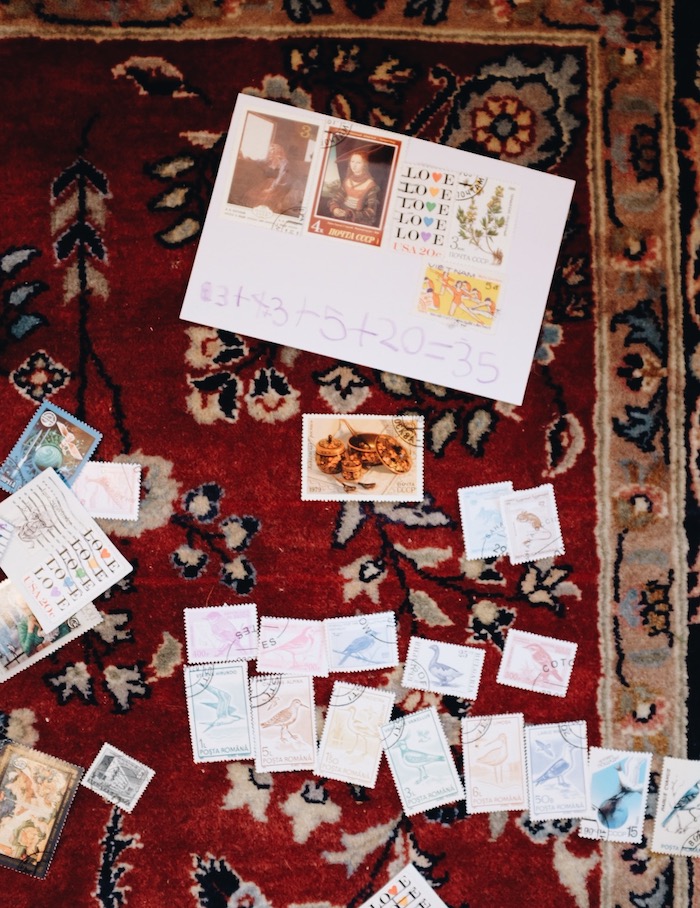
I’d love to know how much time you spend on schoolwork, and what the girls think of it – especially Lux, since she went to a brick and mortar school for a bit.
We spend about three hours on schoolwork a day. There is some reading aloud and tons of (voluntary!) reading alone time in addition to that, but I like to be done with most of the group and individual work by lunchtime, if we begin around nine.
They seem to love it. If they were asking to do something else, we’d likely be doing it!
Lux was originally tempted into homeschool by observing the material her younger sister was learning through Classical Conversations when Lux was going to public school. We noticed she was very engaged in the material and often asked to study with Joan. On the mornings when she would ask to stay home, we would say she was welcome to homeschool next year if that was what she wanted. And she often said, “yes! That’s what I want.”
Lux remembers school very fondly and is nostalgic for aspects of it. Occasionally she will make remarks that reveal how loud and chaotic she found it, how the waiting and lining up was frustrating, how repetitive the reading material was and how that bored her. (These are things she either couldn’t articulate or simply never mentioned at the time.)
The things I remember are how little ownership she felt over any projects completed in class, how she was gone the whole day and couldn’t manage to get along with her sisters when she got home though I could see how badly she wanted to, and the general sense of edge-softening/dulling that seemed to happen to her unique curiosities and spirit.
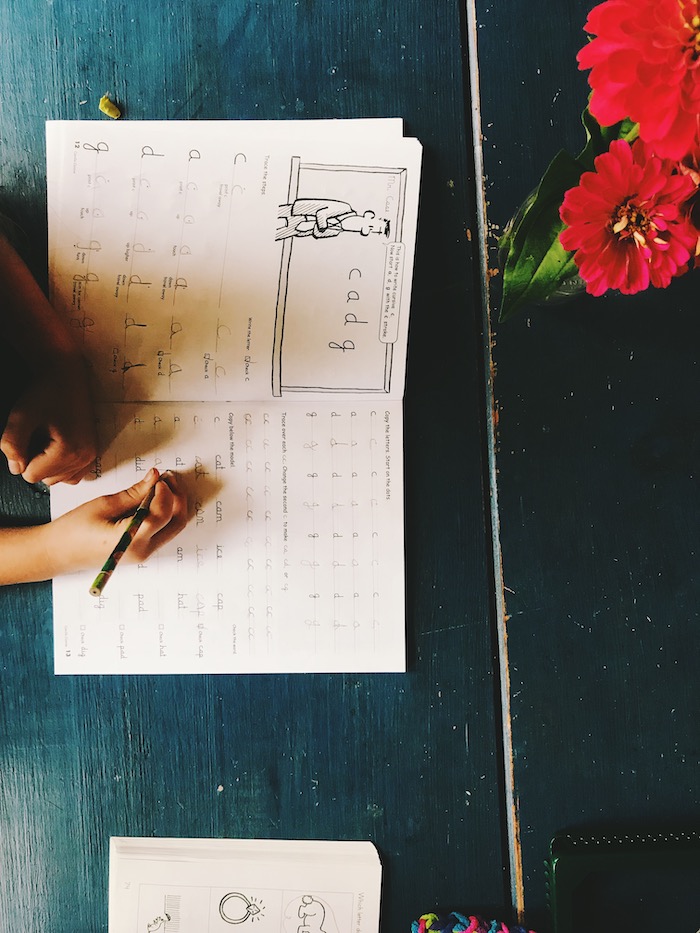
I’d love to know what you’re using, what your days look like, and how you balance school with the little ones!!
We are using :
-Classical Conversations: “CC” A weekly group meet up with a memorized curriculum in seven subjects, science experiments, and fine art experiences.
-Sonlight Curriculum’s history & literature (about an hour of reading per day lined up for the entire year, 3-4 different books daily). This curriculum has a Christian emphasis but most of the titles are not specifically religious.
–Handwriting Without Tears cursive (love the style of these books!)
–Explode the Code phonics (Joan adores these)
-Life of Fred math & everyday math engagement with things like postage stamps and road signs
The newly three-year-old would be the first to tell you she does school. In fact at the doctor’s office when they asked her what was one of her favorite things to do, she said “phonics!”
But really, the morning school hours can be boring for her, and she has to learn to be as least disruptive during this time as she can. It is amazing/delightful to see how much of the material she will engage with. She’ll ask what a word I just read aloud means. She’ll attempt to and sometimes successfully memorize the same material as the girls (a two-year-old singing Latin declensions is unbelievably cute).
She has her own books, crayons, notepad, and letters that come out during this time. None of them catch her attention for long…which is totally normal for that age and I don’t get discouraged by it.
And after each morning session, I gush over how patient she was, and we get a stack of books and read them together, just she and I. Then too her sisters have hours of the day after lunch to play with her and include her in their games—what could be more amazing?
Are you still able to do CC in Vermont and if so how is it going? We started it with my 4 and 6-year-old when we moved to Florida.
Yes! For each house we looked at while house hunting, I used the zip code check to see what CC was in the area, and often reached out to the leader to talk and ask questions about the town and community.
It didn’t determine where we purchased a house, but I would have been surprised/concerned if there hadn’t been a community within 45 minutes.
I know so little about homeschooling, so I’d love to find out how you homeschool three different ages at once. // It interests me so much but I don’t know much about it. Would love the basics including how you handle 3 different ages.
The primary approach with the reading is one-room-schoolhouse style. I read books aloud that the seven-year-old could theoretically read aloud to herself (though she would avoid them because they appear boring) and that the five-year-old may understand most but not all of the material therein. Sonlight Curriculum makes this easy by shipping you a box of books for those ages and laying out the schedule for the year.
But one shouldn’t think they have to pay lots of money to do this kind of thing. There are lots of free programs laid out online and you could compose it with library books and used book purchases in advance. Ambleside Online is a good place to encounter this world.
For CC, the girls memorize the exact same material. The older child is likely grasping the geography of ancient Mesopotamia in a more concrete way than the younger child. And it’s a little easier for her. But they both work at the same thing.
Handwriting, phonics, and math are individualized to their exact level. It takes us about 15-30 minutes with each to do each subject.
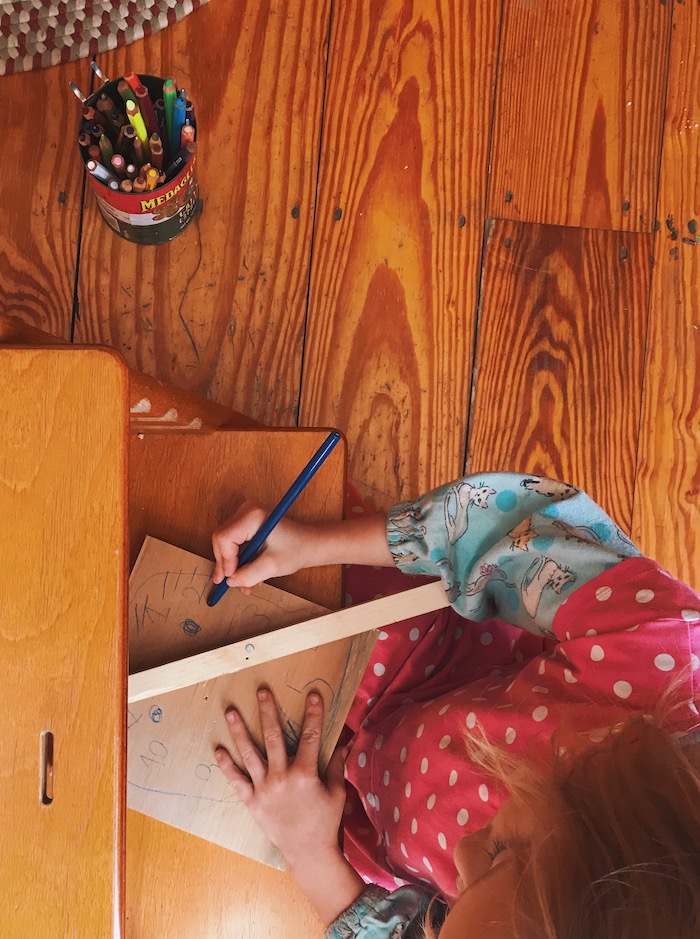
Do you have any suggested reading for those who don’t homeschool but would like supplement with the classical model?
You might enjoy purchasing Classical Conversation’s CDs for the car. Begin with the history sentence songs and see what your children think. I guess they would likely eat it up, and ask you to play it again and again. The Story of the World is also a wonderful book & audiobook (there are four volumes) that can enrich any daily life with history.
Another way to experiment with the Classical Conversations material is to download their app for this year’s cycle C1 (I can’t recommend other cycles as I think they have not been updated). My girls love this on their iPads and they casually review, I’m not making this up, 12 weeks of material in one trip to Boston. Excellent ancient world geography graphics here too.
Geography is a big part of classical education, so I have one more app to recommend: National Giraffic. It’s tough but excellent and fun! I think ages six and above for this one.
I’d love to know more about how to pick a curriculum… And yes, also more about balancing homeschool with multiple ages (my kids are 7 and 3).
This is a tough one because it has so much to do with your preference for emphasis and your child’s interests. If you know anyone homeschooling, you can begin to ask around and learn that way. Check what CC group is in your area (see above for the zip code link), email them and ask to visit and observe a meeting for a day—what’s the harm? I had heard of Classical Conversations for at least a year before I checked it out, and I was originally not interested. Then because it was for my four-year-old, and I had little to lose, I decided to just try it. I wish that I had just looked into it earlier, instead of steering around it.
Sonlight Curriculum’s website and the catalog does a great job of reviewing lots of curriculums for math, handwriting, phonics etc. Click around their language arts section and just see what appeals to you. After that google the names, and you’ll likely find homeschool bloggers talking about why they like it.
I got to see Sonlight Curriculum’s reading style growing up because my mom did it with my little brothers, which is why it was familiar and appealed to me.
For me, her approach was more of an unschooling style, plus I couldn’t grasp reading until “late,” around nine-years-old. Once I could read I embarked on my own curriculum of reading everything I could get my hands on, for hours every day.
The vintage book I review here might be an interesting armchair read for you. It goes into how she organically found a curriculum of sorts and how it morphed over the years.
Do you plan on sending them to a traditional school when they’re older?
I think so. I’d be surprised if we were still homeschooling after middle school. Perhaps if an alternative path became tempting to them—like if one of them wanted to go to culinary school, live abroad, become an engineer, and wanted to complete high school on the side.
As a kid I was homeschooled, transitioned to high school, and though I feel like those years had a lot of wasted time sitting in classrooms, I also loved the sports, theater experience, and close friends that came out of that time.
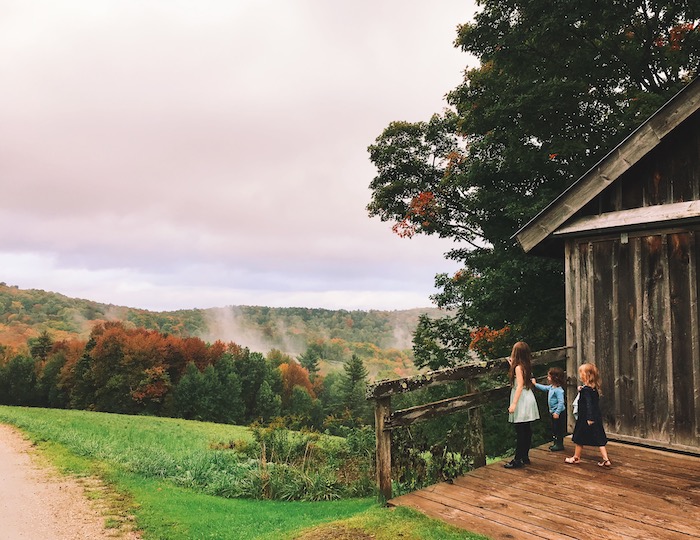
Do you feel pulled in lots of different directions? I feel nutso helping my 11, 9, and 6 year olds with homework after school with the 3 yr old cruising around…in my head I multiply that painful 1.5 hour of the day to equal a day of homeschool ? my kids beg to homeschool (their cousins do, and so does our babysitter) but I’m also worried I’d let a lot of things slide under the guise of “relaxed” schooling or “unschooling” or “guided learning.” I guess my question is…how do you be the only adult in charge and stay that way?? ?
Keep in mind you are dealing with your kids after they’ve already had a totally exhausting day at school. Energy is low. Attention span is even lower. Interest level in the topics…probably all time lowest. Deep in their minds, they are processing all the social interactions and moments they had, whether to bring them up to you, what they meant, wait why did that happen, etc.
I’m reading things aloud that the girls say, “please keep reading!” when I’m done. They are proud of their memorization skills. I get to see them have the “aha!” moment with topics and work through them. Yes, it’s for sure distracting to them when the three-year-old interrupts every seven minutes with a random question.
Your older two would probably have quite a bit of solo work that they would be responsible to complete on their own (and could probably do in 15-20 minutes what would typically take a classroom “hour.”). The Unlikely Homeschool could be a good resource for you here—I’m not as sure about what the great curriculums are for those ages.
And you likely would have things that felt relaxed to you! Because as soon as a kid is interested in something (and they are able to read), they can often take it from there. That would feel easy, but in fact, you’d be watching as they took an interest and turned it into a passion, conquered it, and picked a new one.
Wondering how Lux is feeling about homeschooling after being in public school; and whether any of your daughters are extroverts, and if so, how you meet their need to gab & interact with lots of people all the time. (We’re thinking about homeschooling our kindergartener once the school year is over and these two issues are heavy on my mind!) // Do you feel like your children are getting enough “socialization” at home? Is that ever a worry for you? My husband and I are both introverts and I feel like our daughter is very extroverted, but I also feel like I was extroverted as a child, but a lot of school experiences made me more shy and introverted. I sometimes feel like I’m depriving her of socialization just because we would rather take a walk around the neighborhood as a family or go for a hike than spend the day with other families, even if she does seem perfectly content with these activities.
Yes, the oldest is an extrovert. That aspect of her is something I’m very sensitive to, and as a mom, I go a little out of my way to make sure she gets engagement. Whether it’s paying special attention to her request to take a class, a play date that takes some planning to make happen, potlucks, church Sunday school, willingly signing her up for sleepover camp, and just keeping tabs on how she’s doing.
In general, I don’t believe traditional school offers the unstructured social time extroverted children crave. I also don’t believe children need as much peer socialization as is often implied.
What’s working?! I feel like it changes a lot and sometimes my “philosophy” has to bend a little to make the day go smoothly.
What’s working for me right now is to strive not to take it for granted. Life feels brief, childhood feels even briefer. There are lots of moments that would feel easy to shrug at–giggling at Winnie-the-Pooh’s old fashioned language together, the girls reading to each other on the couch, cheerfully playing each other’s games with absurd rules, widening their eyes with curiosity at a new idea or topic, finding a new favorite aisle of the library to settle in for an hour.
These are in fact moments that are absolutely unique to a very short period of life.
all of the above and how you self care? really looking forward to this post ?
Once I decided that 3-4 hours was sufficient for what we wanted to accomplish each day, I became pretty clear that my on-call time was done after that. At lunch, I’ll say, “what will you guys do this afternoon?” If I’m reading or writing and they keep (joyfully, no doubt) coming up to me with various remarks, I’ll tell them it’s distracting and I want to be left alone for a while.
If I’m doing any kind of housekeeping, I try to make sure they are aware of what’s going on and are asked to help however they can.
When I first considered homeschooling, I had a secret theory that most moms doing it had a hack that was helping them. A husband with a flexible schedule. A mother-in-law down the street. A house cleaner. A babysitter for a few hours a day prepping dinner and playing card games. (I mention this survival theory in my review of this book.)
And for the most part, I’ve found this theory to be proven true. My hack is that Joe is now working from home. And though he disappears into his office for hours at a time, he is still an adult presence in the vicinity and this goes a long way. He can stop by when I’m prepping dinner and chat for a few minutes. He eats lunch with us and quizzes the girls about their morning. He can stay with a sleeping baby if I run out to do errands with the other two. These little things help a lot.
Admittedly, I’m not getting ninety minutes of silence every day. I’m not even getting sixty minutes of silence. It’s a phases of life thing. Cuddling kids on the couch and read books. Hear their creative story unfold as they quietly talk to their toys. Wake up slowly and make pancakes. Put my feet in front of the fire and say, “wow I did that today.” Feel totally normal sprawled on the library floor playing Candy Land with all the wrong rules. Spend an afternoon worrying over a random fever and questioning a nurse closely over the phone. I get those things.
Like so many aspects of motherhood, the decision to homeschool can immediately become burdened with guilt. It’s all on me and I’m not doing enough crop up frequently. Signing up for too much and feeling like a failure when you can’t pull it off. Giving up as a result. It’s very important to avoid this for one big reason: If you are providing consistency and respecting the level of interest your child is at, it’s very difficult to screw this up. Honestly. The child’s innate curiosity and drive will win out.
Thank you! Lots of love.
-
whittling
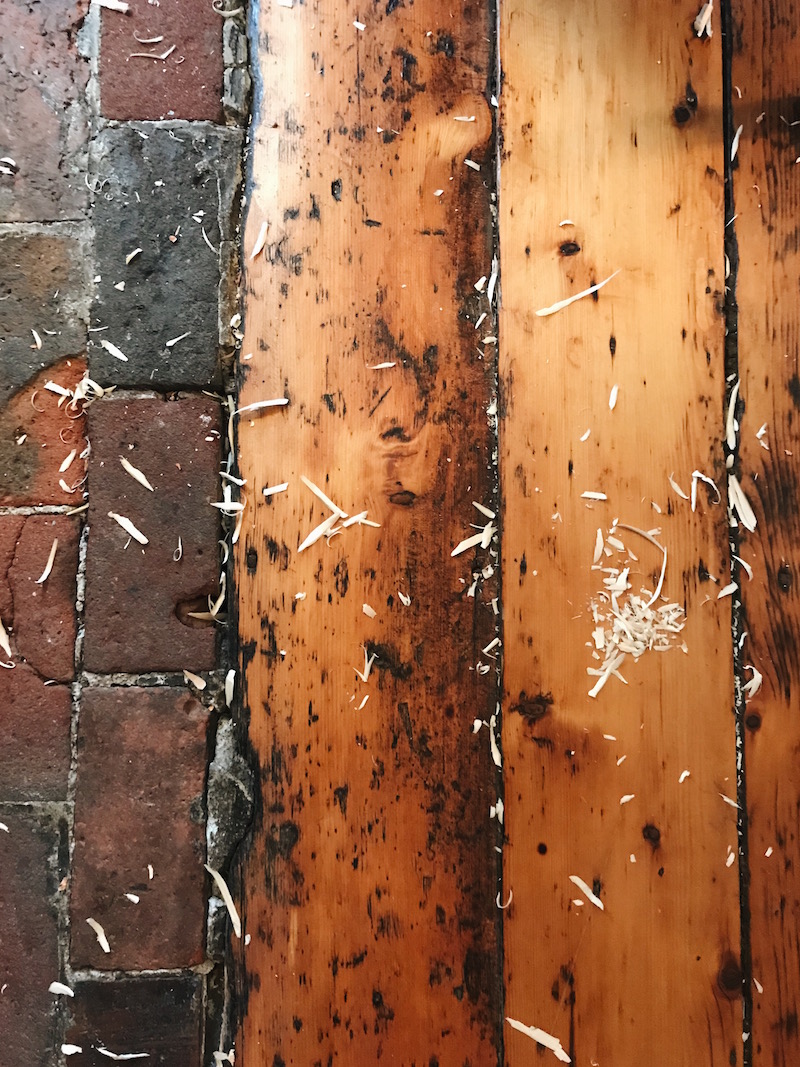
After scouring the internet for recommendations, I finally ordered the predictably! French model of a whittling knife for the girls. The soft curls drift across our floor every day now. Afterwards there is a small trial in sweeping them up into a pile, they would rather sink gently into the floor crevices or let socked feet sally them into distant corners. But they make like a pile of feathers to start a fire. Lit with a match they burst into hearty hot flame, encouraging even the most dismally-built fire to glow. I can always use help starting a fire myself if Joe happens to be in the city (a phrase I use now) or working in the other room.
So far the only human injured in the whittling hobby has been an adult. The girls seem to mostly make sharp pointy objects, nibs of arrowheads scattered around the living room. I’ve suggested something softer and rounder–like a wooden stone? A gentle bird at rest in the hand? They’ll get there. One evening the two-year-old came up to me with a piece of wood in hand: “Mama, I need a knife. I want to whittle.” Sorry kid. Mama already screwed up one child by blessing her deft precocious hand too early, and scaring her away from mandolines forever. You’ll have to wait till you’re…four?
Speaking of future opportunities, the girls have been busy assigning ages to things that I may have murmured to them at one point: earrings, age 12. Cell phones, age 13. Mothers should never utter age ultimatums out loud. An excellent parenting book would include a chapter of stalling techniques. “I’ll have to check with your grandmother.” “That one might be legislated by the state, we’ll look into it, shall we?”

Last night I was on Ambleside online, browsing again, the intriguing world of Charlotte Mason homeschooling. In the realm of homeschooling curriculums, Charlotte Mason comes across as the mysterious ancient prophet of it—espousing her own unique ideas like narration, nature journaling, dictation, and the power of a few things done perfectly. Like some sort of Gospel epistle writer of erudition there are six volumes of her writing on the topic of homeschooling, rife with words like obedience, perfect execution, fresh air and weak literature.
Wouldn’t mind a Virgil to guide me through it. Meanwhile I’ll pick back up with Consider This, a book that discusses the melding of classical and Charlotte Mason ideas.
House projects abound. We nearly stumble over them on our walk to the breakfast table, so many things we’d like to do. Here’s a nook in the kitchen that I hoped would be a spot to keep the cook company–lounge before meals, curl up with a book by the light of the baking bread, nursing a baby and a glass of wine, and that’s just what it’s become. The previous owners had a big antique dish cabinet that filled up the space, and it looks like before that it had a wood stove.
